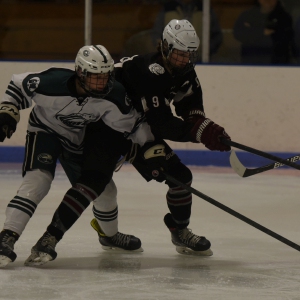MIAA Blue Ribbon Committee tables decision on viability of volleyball rules concerning boys playing on girls teams
| Published: 05-28-2020 5:15 PM |
The MIAA Blue Ribbon Committee tabled a decision on the viability of two volleyball rules concerning boys playing on girls teams.
After hearing a virtual presentation by the MIAA Volleyball Committee on Thursday, the Blue Ribbon Committee (BRC) chose to keep the status quo for the next year until more information can be brought forward on the rules in question.
The BRC was formed a few years ago to review the MIAA handbook with a focus on equality. Any proposed change by the BRC would advance to the board of directors for approval.
Girls volleyball is a fall sport and boys volleyball is a spring sport. If a school does not have a boys team, a boy is eligible to play for the girls team. Amherst Regional, Belchertown, Easthampton, Frontier Regional, Holyoke, Smith Vocational and South Hadley have girls programs. Belchertown and Holyoke have boys programs. Granby will have a varsity girls team this fall and a varsity boys team next spring for the first time.
The BRC has recommended eliminating rules 83.5.1 and 83.5.2 of the MIAA handbook in order to comply with gender-neutral mandates. The rules fall under 83.5 on boys playing on a girls team.
Rule 83.5.1 states: “It is a fault for a male player on a mixed gender girls’ team to attack a ball, if, on contact, the ball is both completely above the height of the net and in the ‘front zone.’ The play becomes illegal when the ball has completely crossed the net untouched or is legally blocked by an opponent. Rule applies to male players in both front row and back row. The location of the ball and not the player is a determining factor (other factor — ball must be completely above the height of the net on contact).”
Rule 83.5.2 states: “Only female front row players are permitted to participate in a completed block.”
According to the MIAA, a combined 31 boys played on 17 girls teams in 2017. In 2018, 27 boys played on 19 girls teams. Figures for 2019 were not available.
Article continues after...
Yesterday's Most Read Articles
 Treehouse, Big Brothers Big Sisters turn race schedule snafu into positive
Treehouse, Big Brothers Big Sisters turn race schedule snafu into positive
 Northampton man will go to trial on first-degree murder charge after plea agreement talks break down
Northampton man will go to trial on first-degree murder charge after plea agreement talks break down
 Area property deed transfers, April 25
Area property deed transfers, April 25
 Contentious dispute ends as Hampshire Regional schools, union settle on contract
Contentious dispute ends as Hampshire Regional schools, union settle on contract
 South Hadley’s Lauren Marjanski signs National Letter of Intent to play soccer at Siena College
South Hadley’s Lauren Marjanski signs National Letter of Intent to play soccer at Siena College
 Primo Restaurant & Pizzeria in South Deerfield under new ownership
Primo Restaurant & Pizzeria in South Deerfield under new ownership
The volleyball committee’s presentation centered on several aspects of player safety with regard to keeping the rule in place in addition to a competitive disadvantage for girls if the rules are overturned.
Other than the height of the net, the rules as set by the National Federation of State High School Associations between boys and girls volleyball are the same, according to Carole Burke, an official and rules interpreter for the MIAA.
It’s the difference in net height — 7-41/8 for girls vs. 7-11⅝ for boys — that puts girls’ safety at risk if a boy played on the front line.
In 2005 a female player for Stoneham separated her shoulder trying to block a hit by a boy who was playing on the front line. The current rules were put in place in 2007, basically relegating boys to the back line.
According to the Volleyball Committee, other types of injuries girls have sustained with boys playing on the front include broken fingers and noses, concussions and in one case a detached retina.
Complicating the matter is Title IX and state law that protects students based on gender identification. Under the MIAA guidelines for Title IX, injuries are not enough for the current rule to stand in court should it be challenged.
Section 3 states: “Student safety has not been a successful defense to excluding students of one gender from participating on teams of the opposite gender. The arguments generally fail due to the lack of correlation between injuries and mixed-gender teams.”
Maintaining the rights of non-binary and transgendered players also needs to be weighed in regards to the current rules.
Erin Buzuvis, a law professor at Western New England University and a Title IX expert, serves on the Blue Ribbon Committee. She recommended the volleyball committee build a proposal centered on gender-neutral alternative language to the current rule backed by more data about injuries (i.e. boys vs. boys, girls vs. girls rather than just boys vs. girls).
Another recommendation to the volleyball committee moving forward was the potential to modify the rules using a combination of the NFHS rule book as well as USA Volleyball, which has rules for “reverse coed volleyball,” including net height.
The BRC said this matter will be a priority on its agenda moving into 2020-2021.
Mike Moran can be reached at mmoran@gazettenet.com. Follow on Twitter @mikemoranDHG.
]]>

 Baseball: Chace Earle shuts down Easthampton in Hopkins Academy’s 13-0 win
Baseball: Chace Earle shuts down Easthampton in Hopkins Academy’s 13-0 win 2024 Gazette Ice Hockey Player of the Year: Cooper Beckwith, Amherst
2024 Gazette Ice Hockey Player of the Year: Cooper Beckwith, Amherst High schools: Northampton boys tennis takes down Amherst in rain-shortened title-game rematch (PHOTOS)
High schools: Northampton boys tennis takes down Amherst in rain-shortened title-game rematch (PHOTOS) High schools: South Hadley baseball shakes off slow start, runs past Granby
High schools: South Hadley baseball shakes off slow start, runs past Granby
